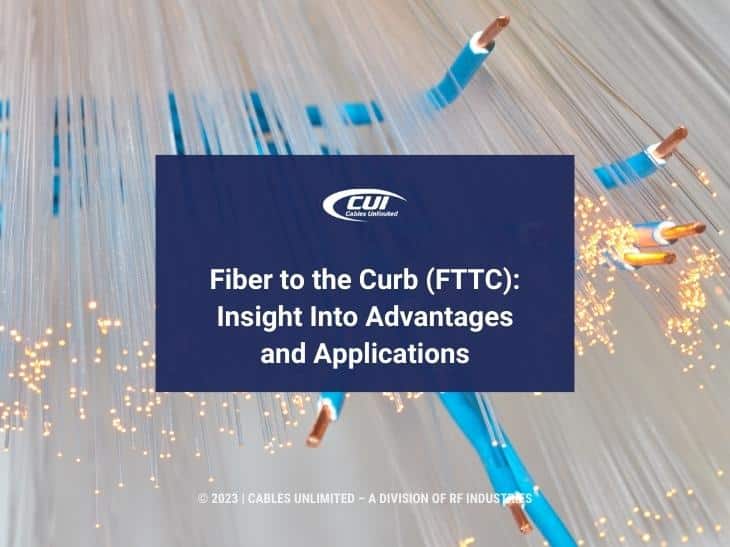Whether it’s Fiber to the Curb (FTTC) or any other acronyms, including FTTN, FTTH, or FTTD, it’s all driven by fiber optics to extend the reach of high-speed broad-bandwidth data services.
This article defines Fiber to the Curb, discusses its many advantages and applications, and shows you how to take the next steps in selecting a custom cable manufacturer for your projects.
What Is Fiber to the Curb (FTTC)?
Fiber to the Curb (FTTC) is a hybrid optical fiber and copper network architecture. It provides fiber optic cabling to a utility pole, a street cabinet, or the “curb.” At that point, the existing coaxial cable, fiber cable or twisted pair wire completes the network route to the home or business.
FTTC delivers increased broadband network capabilities well above the capabilities of coaxial cable or twisted pair copper wiring. In addition, while providing higher speed and bandwidth, its hybrid approach offers cost savings over other options. In the cable television industry, it’s typically referred to as a hybrid fiber coaxial network (HFC Network).
Here’s a quick listing of the other fiber optic network architectures (FTTx) to put FTTC into a better perspective.
- Fiber to the Node (FTTN). This network service is similar to FTTC, but instead of serving a few nearby homes or offices, it’s positioned to serve several hundred homes. That approach uses less fiber and much more copper, resulting in lower speeds and bandwidth.
- Fiber to the Home (FTTH). This takes the next step from FTTC by linking every home to the network directly with fiber optic cables. This type of connection can also be called Fiber to the Premises (FTTP) or Fiber to the Building (FTTB). Read more in our article Fiber to the Home Growth — How and Why Insight.
- Fiber to the Desk (FTTD). This is the ultimate network approach, which provides network services to every desk using fiber optic cables.
If we carry this just a bit further, perhaps in jest, we’re sure someone is working on FTTF, fiber to the fridge, all as part of the Internet of Things.
FTTH and FTTC in the USA: Driving Cloud Computing and IoT
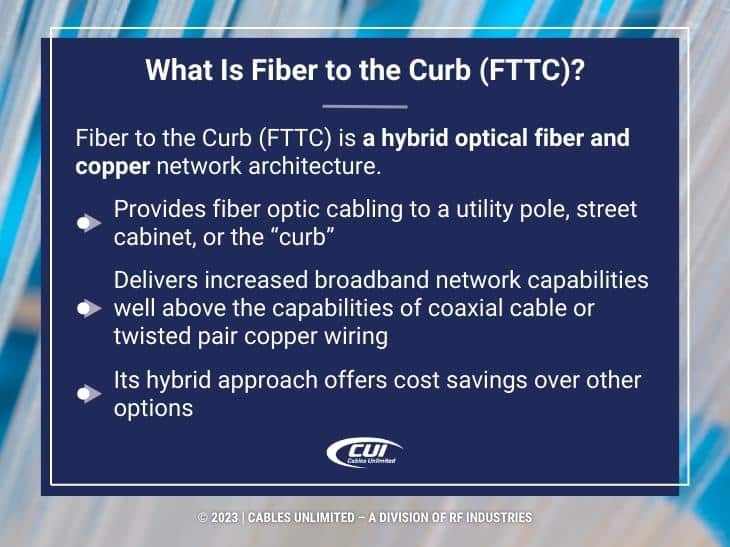
Fiber to the Curb Advantages
As a starting point, the advantages of fiber optic cables include higher transmission speed, broader bandwidth, reduced signal attenuation, enhanced security, reduced interference, and improved durability. Those same attributes position it perfectly for a future of additional streaming and data content as well as more and more end users.
Fiber to the Curb’s hybrid approach brings all these advantages and offers lower costs using the existing copper line. That eliminates digging and routing lines to premises since those lines are already there, saving time and money. FTTC can also save by utilizing the premises’ power connections for the curb-to-premises routing. That, too, saves time and money.
The downside of FTTC is that the copper connections lower both speed and bandwidth. They also bring all the other copper issues, from more maintenance and reduced security to disruptions from EMI and RFI.
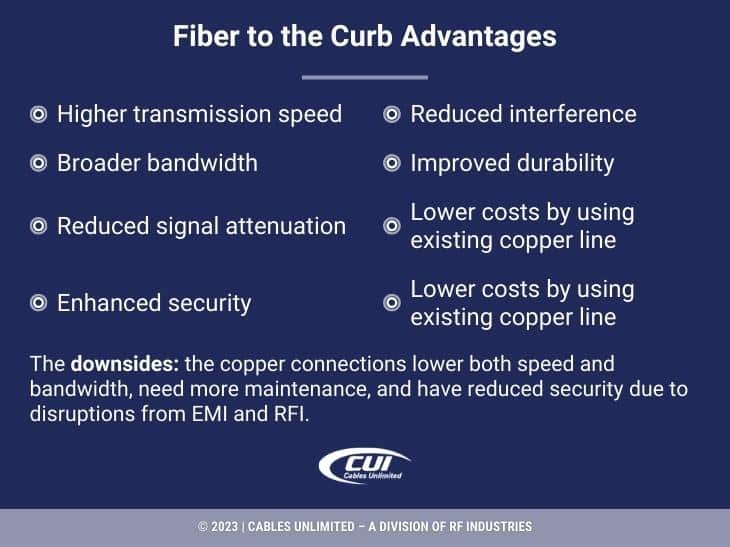
Fiber to the Curb Applications
Fiber to the Curb can be an interim solution in the journey to Fiber to the Home and even Fiber to the Desk. As speed and bandwidth increase along that continuum, the number of applications increases. Or, at a minimum, the performance of those applications improves. Here’s a quick list of FTTC applications.
- Entertainment. The growth in streaming services and online gaming took off during the pandemic and remains a go-to source of entertainment. The high speed and broad bandwidth of FTTC are critical to delivering these services.
- Education. High-speed data services can drive online education from simple Zoom classroom meetings to Massive Open Online Courses (MOOC) delivered to your home. Here again, FTTC is one crucial step to opening up access from home.
- Work from Home. FTTC allows access to video conferences, file sharing, and all cloud-based applications. It also supports VOIP, voice over Internet phone services. All these services are vital to sustaining work from home as a viable full- or part-time option.
- Safety and Security. Security and fire monitoring services use online connectivity to monitor homes and offices. That is now extending to the Internet of Things, using a wide array of “things” to keep track of what’s going on and drive any needed response.
- Smart City Infrastructure. Usually, smart city infrastructure applies fiber optic networks throughout a city. But a sound, cost- and time-effective approach is to use Fiber to the Curb with its hybrid fiber-copper approach as an excellent starting point.
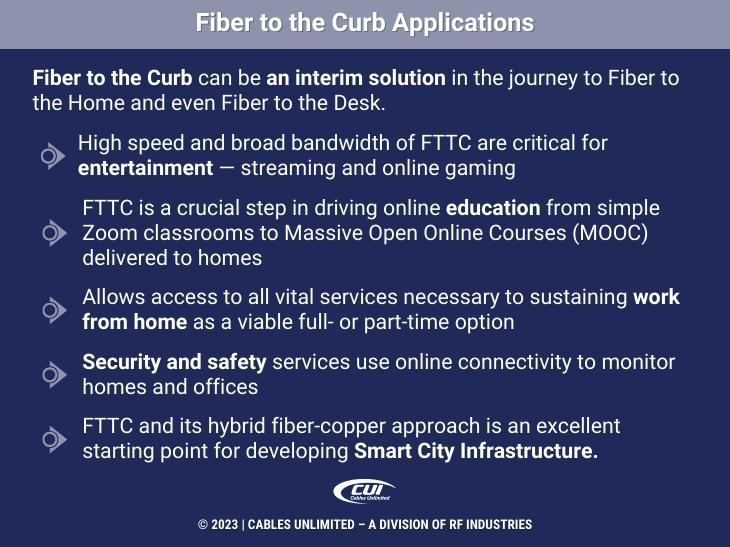
Choosing the Best Custom Cable Manufacturer
Choosing the best cable manufacturer for your business is critical for your success and the success of your projects. Plus, it’s not easy to manufacture fiber optic cable assemblies. It requires years of experience and deep expertise. It’s even better to find all those products and services from a cable manufacturer in the USA.
In our article 10 Tips for Choosing the Right Cable Harness Manufacturer we’ve outlined the key things to look for when selecting your supplier. They include expertise and experience in your industry, producing cables that match your needs, delivery speed, component sourcing capabilities, and lower product costs. You should also expect extensive design, production, and testing resources, including skilled people with the necessary equipment.
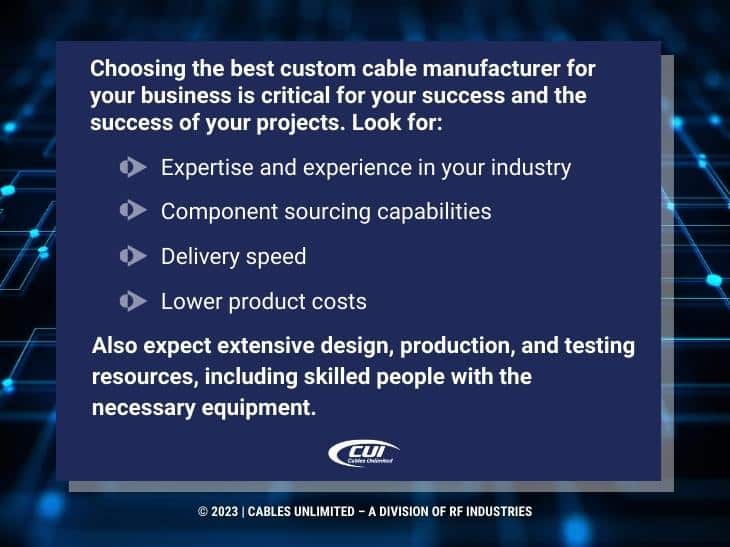
We Can Meet Your Fiber to the Curb (FTTC) Needs
We’ve got you covered if you’re looking for custom fiber optic cable assemblies. Plus, we are a Corning Gold House Partner and work with many others to source the right materials for your fiber optic cable assemblies, wire harnesses, and hybrid cables. We also have extensive in-house capabilities.
If your requirements are already specified and ready for a quote for your current projects, we are prepared to meet your deadlines and pricing targets. Our extensive in-house services and advanced manufacturing capabilities are in place to meet your requirements.
But Cables-Unlimited offers much more than state-of-the-art manufacturing – our dedicated team is also known for going to great lengths to meet the needs of our customers, including working round-the-clock to meet tight turnaround time requirements.
Our sales representatives are standing by to assist you with product questions and quotes Monday – Friday, 8:00 am to 5:00 pm Eastern. Of course, you can also email us or complete our contact form, and we’ll get right back to you.

